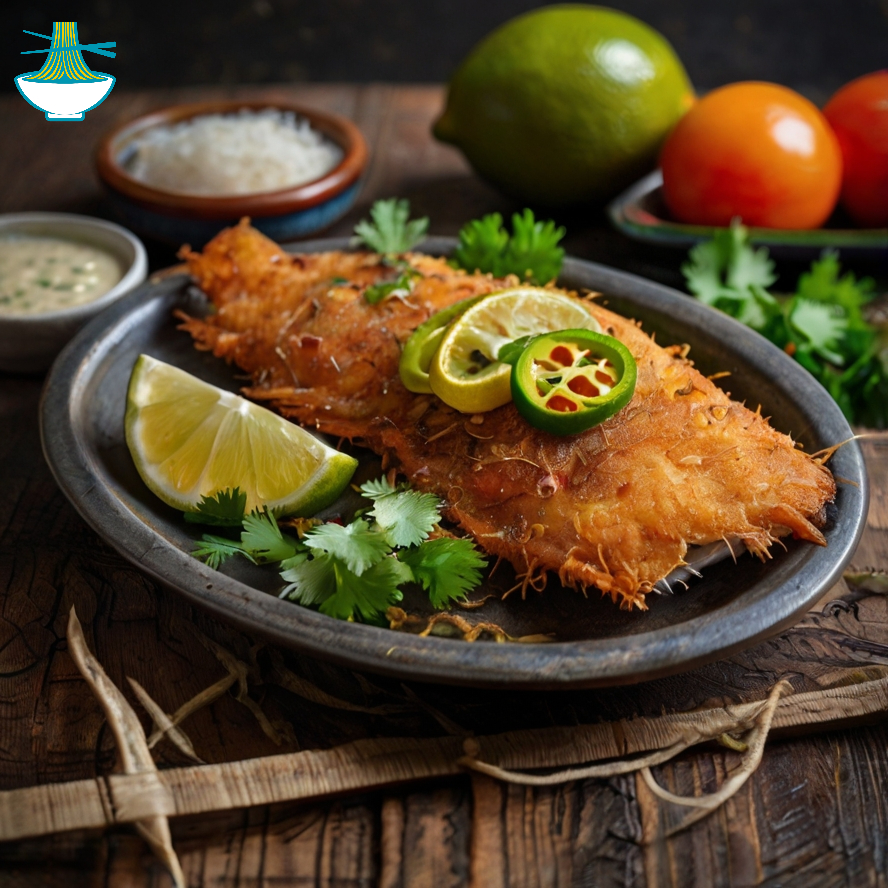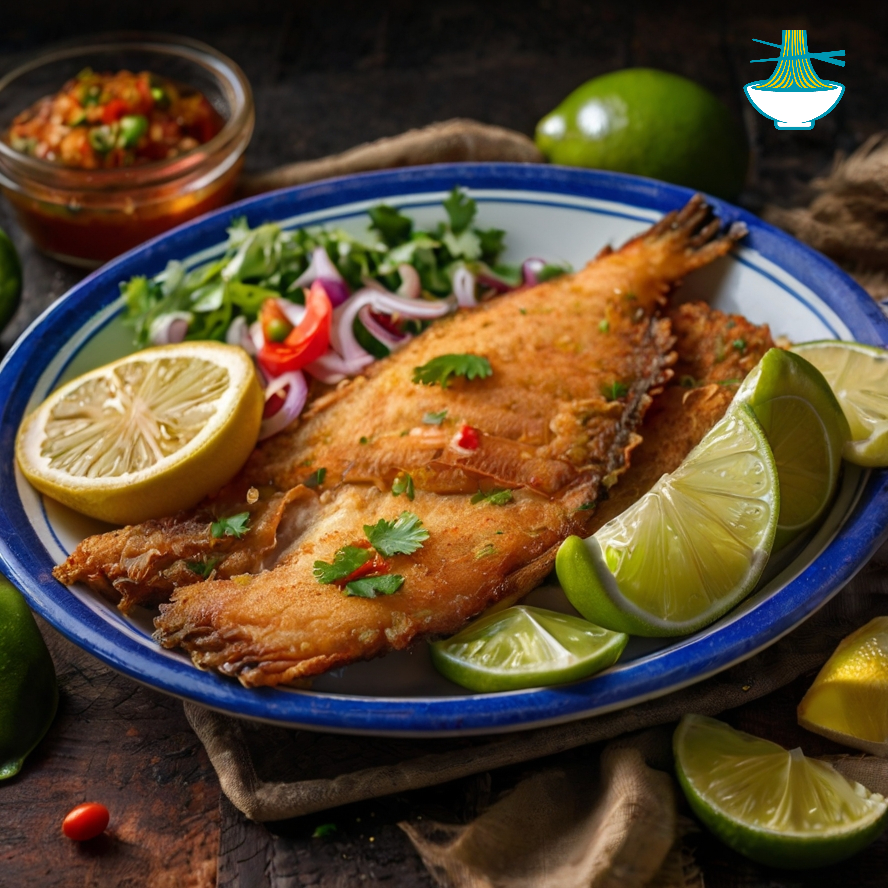Salvadoran Fried Fish is a cherished seafood dish from El Salvador, known for its crispy, golden-brown exterior and tender, juicy interior. This dish reflects the vibrant flavors of Salvadoran cuisine, with a simple yet flavorful coating of seasoned flour that enhances the natural taste of the fish.

Salvadoran Fried Fish has its roots in the coastal regions of El Salvador, a country with a rich seafood tradition due to its extensive Pacific coastline. The practice of frying fish is believed to have been influenced by the indigenous Lenca and Pipil people long before the Spanish arrived. Over generations, this technique has been refined and passed down through families, incorporating local spices such as garlic powder, paprika, and cumin to create the distinctive Salvadoran flavor. Though exact historical records may be sparse, the dish remains a popular staple at family gatherings, festive occasions, and beach outings in El Salvador.
Ingredients:
- 1-2 pounds fresh whole fish (e.g., red snapper or tilapia), cleaned and scaled
- 1 cup all-purpose flour
- 1 teaspoon garlic powder
- 1 teaspoon paprika
- 1 teaspoon cumin
- 1 teaspoon salt
- 1/2 teaspoon black pepper
- Vegetable oil, for frying
- Lime wedges, for serving
Method:
1. Prepare the Fish: Rinse the fish under cold water, remove scales, and ensure the insides are clean. Pat dry with paper towels.
2. Prepare the Coating: In a shallow dish, mix flour, garlic powder, paprika, cumin, salt, and black pepper.
3. Coat the Fish: Dredge the fish in the seasoned flour, coating evenly and shaking off excess.
4. Heat the Oil: Pour vegetable oil into a skillet or deep fryer to about 1 inch depth. Heat over medium-high until it reaches 350°F (175°C). Test with a small piece of bread; it should sizzle and turn golden.
5. Fry the Fish: Place the coated fish into the hot oil. Fry for 5-7 minutes per side until golden brown and crispy. Ensure fish is cooked through and flakes easily. Fry in batches if necessary.
6. Drain and Serve: Use a slotted spoon to transfer fish to paper towels to drain excess oil. Serve hot with lime wedges.
Notes:
- Fresh fish is key for optimal flavor. Look for fish with clear eyes, bright red gills, and firm flesh.
- Adjust spices to taste. Increase or decrease the amount based on preference.
- Pair with traditional Salvadoran sides like curtido (pickled cabbage slaw) and fried plantains for an authentic experience.

Nutrition Value:
1. 1-2 pounds fresh whole fish (e.g., red snapper or tilapia), cleaned and scaled
- Calories: Approximately 200-250 calories per 3-ounce serving
- Carbohydrates: 0 grams
- Protein: About 20-25 grams
- Fat: 5-10 grams
- Sodium: 50-60 milligrams
- Cholesterol: 60-80 milligrams
- Vitamins: Rich in B vitamins, particularly B12
- Minerals: Good source of selenium, phosphorus, and potassium
Nutritional Benefits:
Fresh fish is high in protein, which supports muscle growth and repair. It's also rich in omega-3 fatty acids, which are beneficial for heart health and brain function. The vitamins and minerals in fish contribute to overall health, including immune support and bone health.
2. 1 cup all-purpose flour
- Calories: Approximately 455 calories
- Carbohydrates: 95 grams
- Protein: 13 grams
- Fat: 1 gram
- Sodium: 2 milligrams
- Cholesterol: 0 milligrams
- Vitamins: Minimal vitamins, though some may be fortified with B vitamins
- Minerals: Provides small amounts of iron and calcium
Nutritional Benefits:
All-purpose flour primarily provides carbohydrates, which are a source of energy. It also contributes a small amount of protein and iron. While not a significant source of vitamins, fortified flour can offer some B vitamins that aid in energy metabolism.
3. 1 teaspoon garlic powder
- Calories: About 5 calories
- Carbohydrates: 1 gram
- Protein: 0 grams
- Fat: 0 grams
- Sodium: 1 milligram
- Cholesterol: 0 milligrams
- Vitamins: Contains trace amounts of vitamin C
- Minerals: Small amounts of calcium, iron, and magnesium
Nutritional Benefits:
Garlic powder adds flavor with minimal calories. Garlic is known for its potential health benefits, including antioxidant properties and supporting heart health by potentially reducing cholesterol levels.
4. 1 teaspoon paprika
- Calories: About 6 calories
- Carbohydrates: 1 gram
- Protein: 0 grams
- Fat: 0.3 grams
- Sodium: 1 milligram
- Cholesterol: 0 milligrams
- Vitamins: High in vitamin A
- Minerals: Contains iron and small amounts of calcium and magnesium
Nutritional Benefits:
Paprika provides antioxidants, particularly vitamin A, which supports vision and immune function. The small amounts of iron help in maintaining healthy blood.
5. 1 teaspoon cumin
- Calories: About 8 calories
- Carbohydrates: 1 gram
- Protein: 0.4 grams
- Fat: 0.4 grams
- Sodium: 1 milligram
- Cholesterol: 0 milligrams
- Vitamins: Contains some vitamin C
- Minerals: Good source of iron and calcium
Nutritional Benefits:
Cumin adds flavor and contributes iron, which is essential for oxygen transport in the blood. It also contains antioxidants that may support digestive health and overall wellness.
6. 1 teaspoon salt
- Calories: 0 calories
- Carbohydrates: 0 grams
- Protein: 0 grams
- Fat: 0 grams
- Sodium: 2,300 milligrams
- Cholesterol: 0 milligrams
- Vitamins: 0
- Minerals: Sodium
Nutritional Benefits:
Salt is primarily used to enhance flavor but should be used in moderation due to its high sodium content, which can impact blood pressure and heart health if consumed in excess.
7. 1/2 teaspoon black pepper
- Calories: About 3 calories
- Carbohydrates: 0.7 grams
- Protein: 0.1 grams
- Fat: 0.1 grams
- Sodium: 0 milligrams
- Cholesterol: 0 milligrams
- Vitamins: Contains some vitamin K
- Minerals: Small amounts of calcium, iron, and potassium
Nutritional Benefits:
Black pepper has antioxidant properties and can aid in digestion. It also provides a small amount of vitamin K, which is important for blood clotting and bone health.
8. Vegetable oil, for frying
- Calories: Approximately 120 calories per tablespoon
- Carbohydrates: 0 grams
- Protein: 0 grams
- Fat: 14 grams
- Sodium: 0 milligrams
- Cholesterol: 0 milligrams
- Vitamins: Small amounts of vitamin E, depending on the type of oil
- Minerals: Varies depending on the oil used
Nutritional Benefits:
Vegetable oil provides fat, which is essential for energy and absorption of fat-soluble vitamins. It can also contain vitamin E, an antioxidant that supports skin and immune health.
9. Lime wedges, for serving
- Calories: About 11 calories per lime wedge
- Carbohydrates: 3 grams
- Protein: 0.2 grams
- Fat: 0 grams
- Sodium: 1 milligram
- Cholesterol: 0 milligrams
- Vitamins: High in vitamin C
- Minerals: Contains potassium and trace amounts of calcium and magnesium
Nutritional Benefits:
Lime wedges provide a good source of vitamin C, which supports immune function and skin health. The small amounts of potassium can aid in maintaining fluid balance and heart health.


Comments